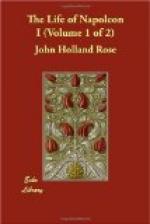* * * * *
CHAPTER V
THE ITALIAN CAMPAIGN
(1796)
In the personality of Napoleon nothing is more remarkable than the combination of gifts which in most natures are mutually exclusive; his instincts were both political and military; his survey of a land took in not only the geographical environment but also the material welfare of the people. Facts, which his foes ignored, offered a firm fulcrum for the leverage of his will: and their political edifice or their military policy crumbled to ruin under an assault planned with consummate skill and pressed home with relentless force.
For the exercise of all these gifts what land was so fitted as the mosaic of States which was dignified with the name of Italy?
That land had long been the battle-ground of the Bourbons and the Hapsburgs; and their rivalries, aided by civic dissensions, had reduced the people that once had given laws to Europe into a condition of miserable weakness. Europe was once the battle-field of the Romans: Italy was now the battle-field of Europe. The Hapsburgs dominated the north, where they held the rich Duchy of Milan, along with the great stronghold of Mantua, and some scattered imperial fiefs. A scion of the House of Austria reigned at Florence over the prosperous Duchy of Tuscany. Modena and Lucca were under the general control of the Court of Vienna. The south of the peninsula, along with Sicily, was swayed by Ferdinand IV., a descendant of the Spanish Bourbons, who kept his people in a condition of mediaeval ignorance and servitude; and this dynasty controlled the Duchy of Parma. The Papal States were also sunk in the torpor of the Middle Ages; but in the northern districts of Bologna and Ferrara, known as the “Legations,” the inhabitants still remembered the time of their independence, and chafed under the irritating restraints of Papal rule. This was seen when the leaven of French revolutionary thought began to ferment in Italian towns. Two young men of Bologna were so enamoured of the new ideas, as to raise an Italian tricolour flag, green, white, and red, and summon their fellow-citizens to revolt against the rule of the Pope’s legate (November, 1794). The revolt was crushed, and the chief offenders were hanged; but elsewhere the force of democracy made itself felt, especially among the more virile peoples of Northern Italy. Lombardy and Piedmont throbbed with suppressed excitement. Even when the King of Sardinia, Victor Amadeus III., was waging war against the French Republic, the men of Turin were with difficulty kept from revolt; and, as we have seen, the Austro-Sardinian alliance was powerless to recover Savoy and Nice from the soldiers of liberty or to guard the Italian Riviera from invasion.




